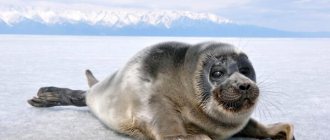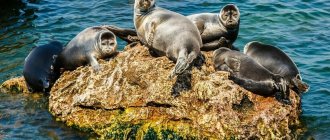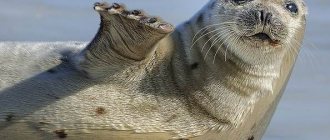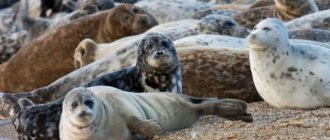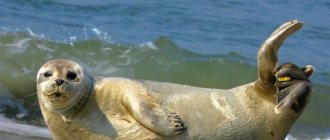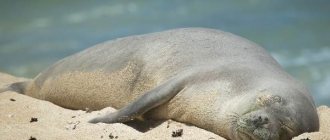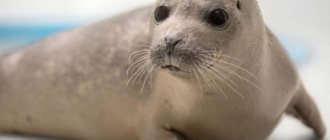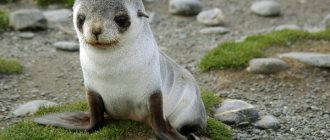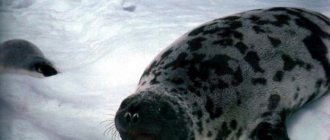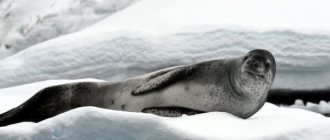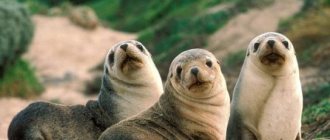Ringed seals - These are small mammals from the genus of common seals. I also call them ringed seals or akibs. They got their name thanks to the interesting patterns on the back, shaped like rings. Thanks to their thick subcutaneous fat, these seals can withstand low temperatures, which allows them to settle in the Arctic and subarctic regions. In Svalbard, ringed seals breed on ground ice in all fjords.
In addition to the inhabitants of the northern seas, freshwater subspecies are also observed, which are found in lakes Ladoga and Saimaa.
Description
Akibas are small silver-gray to brown seals. Their bellies are usually gray, while their backs are darker and have a noticeable pattern of small rings, which is how they get their name.
The body is dense, short, covered with plush fur. The head is small, the neck is not long. They have large claws more than 2.5 cm thick, thanks to which they cut holes in the ice. As is known, such burrows can reach depths of up to two meters.
Adult animals reach a length of 1.1 to 1.6 m and weigh 50-100 kilograms. Like all northern seals, their body mass varies markedly depending on the season. Ringed seals are fattest in the fall and significantly thinner in late spring and early summer, after the breeding season and annual molt. Males are slightly larger than females, and in the spring, males appear much darker than females due to the oily secretion of glands in the muzzle area. At other times of the year they are difficult to distinguish. At birth, the cubs are about 60 cm long and weigh about 4.5 kg. They are covered with light gray fur, lighter on the belly and darker on the back. Fur patterns develop with age.
Thanks to well-developed vision, smell and hearing, seals are excellent hunters.
Appearance
The appearance of seals clearly indicates their aquatic lifestyle. At the same time, they did not completely lose contact with land like cetaceans. All types of seals are quite large animals, weighing from 40 kg (for seals) to 2.5 tons (for elephant seals). However, even animals of the same species vary greatly in weight at different times of the year because they accumulate seasonal reserves of fat.
The body of seals is elongated and ridged at the same time, the contours of the body are streamlined, the neck is short and thick, the head is relatively small with a flattened skull. The limbs of the seals turned into flat flippers, with the hands and feet being most developed, and the shoulder and thigh girdles being shortened.
Typically, when moving on land, seals rely on their forelimbs and stomach, while their hind limbs drag along the ground. In water, the front flippers act as a rudder and are hardly used for paddling. This is significantly different from the method of locomotion of eared seals, which actively use all limbs to move both on land and under water.
Real seals do not have ears, and the ear canal is closed by a special muscle during diving. Despite this, seals have good hearing. But the eyes of these animals, on the contrary, are large, but myopic. This structure of the visual organs is characteristic of aquatic mammals.
Of all the senses, seals have the best developed sense of smell. These animals perfectly detect odors at a distance of 200-500 m! They also have tactile vibrissae (commonly called whiskers), which help navigate among underwater obstacles. In addition, some species of seals are capable of echolocation, with the help of which they determine the location of prey under water. True, their echolocating abilities are much less developed than those of dolphins and whales.
Habitat and habits
As mentioned above, the main habitat of these cute predators is the Arctic and subarctic. Throughout most of their range, they use sea ice exclusively as a breeding, molting, and resting site. They crawl onto land rarely and reluctantly.
They lead an isolated lifestyle. They rarely gather in groups; this mainly happens during the mating season, in the warm season. Then in the coastal zone you can find rookeries of ringed seals, numbering up to 50 individuals.
Their ability to create and maintain breathing holes in the ice allows them to live even in areas where other animals, also adapted to low temperatures, cannot live.
Despite their good adaptability to frost, ringed seals sometimes face temperature problems in the Arctic winter. To protect themselves from the cold, they create lairs in the snow on top of the sea ice. Such burrows are especially important for neonatal survival.
Ringed seals are excellent divers. They are capable of diving to more than 500 m, although in the main feeding areas the depth does not exceed this mark.
Lifestyle
Ringed seals never form colonies. Most often they stay alone, although sometimes they gather in small groups, which, however, are not very stable. They spend the whole year at sea, for which their bodies are very well adapted.
In summer, ringed seals stay mainly in coastal waters and in some places form small haulouts on stones or pebble spits. In autumn, as the sea freezes, most of the animals move from the coastal zone into the depths of the sea and stay on drifting ice. A minority of animals remain off the coast for the winter and live in bays and bays. In this case, even at the beginning of the freezing of the sea, the seal makes holes in the young ice - holes through which it leaves the water. There are also smaller holes, used only to breathe through them. Often the opening of the hole is covered with a thick layer of snow, in which the seal makes a hole without an exit hole to the outside. In such a convenient place she rests, being invisible to her enemies, mainly polar bears. The largest concentrations of seals are observed in the spring on drifting ice during pupping, molting and mating. This is especially typical for the seas of the Far East, where in one day of sailing in the ice many hundreds and sometimes thousands of animals can be observed. Most often seals lie in groups of 10-20 animals, but there are clusters of a hundred or more animals.
Nutrition
Outside the breeding and molting season, the distribution of ringed seals is adjusted by the availability of food. Numerous studies have been conducted on their diet, and despite significant regional differences, general patterns emerge.
The main food of these animals is fish, typical for a particular region. As a rule, no more than 10-15 victims with 2-4 dominant species are found in the field of view of seals. They select food that is small in size - up to 15 cm in length and up to 6 cm in width.
They feed on fish more often than invertebrates, but the choice often depends on the season and the energy value of the prey. Typically, the diet of the ringed seal includes nutritious cod, perch, herring and capelin, which are rich in the waters of the northern seas. The consumption of invertebrate animals, apparently, becomes relevant in the summer, and predominates in the diet of young livestock.
LIFE IN THE ICE
The seal spends about six months of the year in the ice. The most important events in the life of this seal are associated with them: wintering, breeding and molting. The seal is relatively evenly distributed throughout Lake Ladoga, but prefers its southern, shallowest part, where permanent ice forms in winter. Up to 80% of seals choose this place to breed. The second most important part of Ladoga is the northern skerry areas, where another 20% of the population breeds. Seals reach sexual maturity only at the age of six. Mating occurs in January. Pregnancy lasts 11 months. Cubs appear in late February - early March.
To rest on the ice, seals use shelters in snow blows among hummocks, the entrance to which is through a hole in the ice. Usually there are several shelters, and in December the pregnant female arranges one of them as a maternity den. The seal's maternity chamber is located at a depth of up to 2 m and is much larger than the others. Its height is about 40 cm, length - 385 cm, and width - approximately 120 cm. Such a chamber can have several compartments connected by tunnels. If there are coastal rocks nearby, they often become one of the walls of the home.
Seals are conservatives. From year to year they use the same places for shelters. Often females build dens quite close to each other, at a distance of 2-3 m. At 5 square meters. km of area suitable for seal life, there can be up to 32 such shelters.
Reproduction
Female ringed seals reach sexual maturity at the age of 4 years, while males only reach sexual maturity at the age of 7 years. Females dig small caves in thick ice on an ice floe or shore. The offspring are born after a nine-month pregnancy in March or April. As a rule, one cub is born. Weaning off milk takes just over 1 month. During this time, the newborn gains up to 20 kg of weight. After just a few weeks, they can stay underwater for 10 minutes.
After the birth of the babies, the females are again ready to mate, usually at the end of April. After fertilization, males, as a rule, leave the expectant mother in search of a new object for copulation.
The life expectancy of ringed seals in the wild, according to various sources, is 25-30 years.
Interesting facts about the animal
- Seals are amazing animals. They have a curious character and are easy to train.
- In their habitats, they swim up to a drifting ship and follow it.
- The seal can accelerate underwater up to 25 km per hour.
- A seal can stop a pregnancy - no other animal has this ability.
- The age of animals can be easily determined by the location of the annual rings on the claws or fangs. This is a unique feature of ringed seals, not characteristic of any other animal.
Number
Available data on ringed seal distribution were compiled and analyzed as part of the 2016 IUCN Red List for the five recognized subspecies. Estimates of the number of mature individuals and population trends for each of these subspecies were as follows:
- Arctic ringed seal – 1,450,000, trend unknown;
- Okhotsk ringed seal – 44,000, unknown;
- Baltic ringed seal – 11,500, population increase;
- Ladoga - 3000-4500, upward trend;
- Saimaa – 135 – 190, increase in subspecies.
Due to the large spatial scale, it is quite difficult to trace the exact number of subspecies in the Arctic and Okhotsk. Citing many factors, such as the vast habitats occupied by the species, uneven occupancy in the surveyed areas, unknown relationships between observed individuals and those not observed, make it difficult for researchers to ascertain the exact number.
However, the above figures indicate that the number of mature individuals is over 1.5 million and the total population is over 3 million individuals.
Mysteries of the Baikal seal
Lake Baikal is famous for its depth, purity of water and beautiful nature around. But he has one more attraction. Once upon a time, unusual seals settled here, and such animals are not found in any other body of water in the world. Therefore, they are called endemics, that is, living in a limited space, in a small habitat.
How did seals end up in Baikal?
The lifestyle of Baikal seals has been well studied. But how and where they got into this body of water remote from the seas and oceans remains a mystery to scientists.
There are 2 more species of freshwater seals: one of them also lives in Russia, in Ladoga, and the other has colonized Lake Saimaa in Finland.
Their appearance there is associated with changes in northern water spaces during the Ice Age, but this explanation is not suitable for the seals of Baikal.
The seal is endemic to Lake Baikal.
What do seals look like?
The Baikal seal is a large and strong animal. It grows in length for almost 19 years and reaches 110-165 cm with a weight of 50-130 kg. The body is shaped like a spindle - it widens towards the head and narrows towards the tail, there is no neck. The front flippers have large claws and are more developed than the hind flippers. Webbing between the fingers.
Baikal seals have a body and flippers protected by short, but dense and hard hair. Its color on the back is brownish-gray with different shades, and on the chest and belly it is light gray with yellowish tint. Sometimes the coloring is spotty.
Long and stiff hairs are visible on the upper lip - these are vibrissae. They are very sensitive and serve the seal for orientation on land and in water.
Important abilities of the seal
Baikal seals have no one to fear in the outside world; only human hunters are dangerous for them
Caution, swimming abilities and inconspicuous color help animals escape from death.
This type of seal tolerates harsh climatic conditions well. A thick layer of fat under the waterproof coat prevents hypothermia, and it also gives strength and energy in case of food shortage.
Water is their element.
During the winter, Baikal seals remain in the water, under the ice. Animals use their claws and teeth to make breathing holes in it in advance and then prevent these holes from freezing until spring.
Seals have well-developed vision, hearing and smell, and their dexterity in moving in water seems incredible. If necessary, they can:
- reach speeds of up to 25 km/h;
- go to a depth of up to 400 meters;
- hold your breath and stay under water for up to 40 minutes.
Hunting and food
The Baikal seal eats 3-5 kg of fish per day, and almost a ton per year. He does not need to compete with humans when obtaining food, because he hunts only non-commercial representatives of the underwater world. But the seal will not refuse to feast on a valuable species if it ends up in the place where it was caught in fishing nets.
Fish is the main delicacy.
Mother seals and their babies
Female Baikal seals give birth to one baby at a time, rarely two at once. This happens in March, in snow holes that mother seals make on the frozen surface of the lake. Newborn seal pups weigh 3-4 kg. They are covered with white fur, which is why they received the nickname squirrel from the locals. This coloring serves them for camouflage in the snowy expanses.
For two months, babies live with their mothers and feed on milk. Then they acquire the necessary skills, switch to a fish diet, molt, and the color of their coat gradually changes.
Maternal care.
Protection of the Baikal seal
Baikal seals are well adapted for survival; 50 years is not the limit for them. And yet, these animals were listed in the Red Book, and at the beginning of the 21st century, hunting for them was banned. The right to production was reserved only for scientists and indigenous peoples living near the lake.
Now the number of seals exceeds 100 thousand individuals. They explore new areas of Lake Baikal and surprise tourists and local residents with their numbers when they come out to the rocky shores to bask in the sun. And most of them are on the Ushkany Islands, on the territory of the Zabaikalsky Nature Reserve.
It's good to bask in the sun.
!
To conclude the message, here are a few more facts from the life of the unique Baikal seals:
- They are curious and specifically look out of the water to watch ships.
- On land, seals are slow and clumsy, and in case of danger they try to move in leaps and bounds.
- These are the only mammals on Lake Baikal.
- Seals sleep in the water, so soundly that scuba divers were able to turn them from side to side.
- Muscovites and guests of the Russian capital can admire these cute animals in the Moskvarium.
Security
In addition to polar bears, which pose the greatest danger to ringed seals, these animals often become victims of walruses, wolves, wolverines, foxes, and even large crows and gulls that prey on their cubs.
However, it was not the natural regulation of the population that caused ringed seals to be included in the Red Book, but the human factor. The fact is that, despite all the protective measures, many peoples of the north continue to hunt seals to this day as a source of valuable meat and skin.
In general, despite various programs, not a single reserve has been created in Mina in which ringed seals could freely increase their population.
Ringed seal in the Red Book
The species is listed in the International Red Book. Has status as a species of least concern. The species is not included in the Red Book of Russia.
Main causes of extinction
The main reasons influencing the decline in the population of the species and leading to its extinction include:
- Deterioration of the condition of lakes and sea waters due to the discharge of wastewater and industrial waste into them.
- Uncontrolled hunting of seals.
- Active human economic activity in animal habitats.
Current population situation
The size of the annular nerve population depends on the condition of the subspecies. The most numerous is the Belomorsky one. There is no threat of population decline.
The Baltic seal has seen a decline in its subspecies; its population does not even reach 50 thousand individuals. Ladoga is about 20 thousand, and Saimaa is about 100 individuals.
What measures are taken to protect
In general, seals are classified as low risk, causing the least concern, by the International Union for Conservation of Nature.
In the Russian Federation, a special conservation program for the conservation of the species has been developed for the Baltic and Saimaa subspecies. In order for an animal to survive in nature, it is necessary to create reserves and monitor their numbers.
The Baikal seal is an endemic with extraordinary abilities
The Baikal seal is a unique and one-of-a-kind mammal of the Siberian Sea! It is believed to be a “relative” of the famous ringed seal, which lives in the cold waters of the Arctic Ocean. The first mentions of the Baikal seal were recorded during the expedition to the North of Vitus Bering.
The fact is that when conducting such expeditions, biologists were necessarily included in the expedition teams. They were the first to compile a detailed description of the famous pinniped endemic to Lake Baikal when they stopped off the shores of the “Siberian Sea”!
The mystery is how did the pinniped get into Lake Baikal?
How did the seal actually end up in Baikal? Or maybe she was in this lake originally? This is still unknown to anyone...
Scientists express the opinion that this Baikal endemic entered the lake during the Ice Age from the Arctic Ocean, sailing along the floodplains of the Siberian Yenisei River, and possibly the Lena River.
It is worth noting: ichthyologists believe that another endemic of the lake, the Baikal omul, migrated to Baikal along the same route!
Amazing ability of a female mammal
One of the most interesting features of the body of a female mammal is that she can somehow influence the course of her pregnancy, stopping it
Where does the Baikal seal winter?
During the cold season, animals live on the ice in special lairs located under the snow. They are often found in hummocky areas of the lake. When Baikal begins to freeze, the animals make their main blowhole on the ice, the average diameter of which is about 150 cm. Interestingly, seals can maintain it in this state for a long time, from time to time removing the ice that forms on it.
When severe frosts occur, when the lake freezes, these animals, being under thick snow, breathe only through secondary vents. To do this, they rake the ice using their forelimbs, which end in strong claws. Thus, a seal’s lair can have up to a dozen similar vents located along its perimeter. The diameter of the secondary vents is no more than 15 cm. Such a hole is enough for the animal to stick its nose there.
Behavior
Adults tend to be solitary and love to travel. In winter, they make holes in the ice for breathing (vents) and maintain them in a non-freezing condition. Some animals, in addition to one main ice hole, build up to 10 additional ice holes and vigilantly ensure that they do not freeze, regularly destroying the thin ice shell by pressing their muzzle from below.
If its thickness reaches 2 cm, then blows with the front flippers are used, and at 3-6 cm, sharp, strong claws are used. This activity takes a lot of time and effort, since the thickness of the ice on Lake Baikal ranges from 60 to 150 cm, and in the bays it reaches 2 m.
In some places of the lake, severe frosts cause the formation of cracks in the ice 10-30 km long and 2-3 m wide, which attract Baikal seals and many fish, which serve as their main source of food.
From March to May, aquatic mammals rush from south to north along with the beginning of ice drift. During this period, all individuals, starting from the age of one year, climb onto a hard surface and molt. Molting most often occurs directly on the ice, less often on coastal stones, and is widespread.
In summer and autumn, individual individuals molt individually or in small groups.
Young animals do not have the ability to dive deeply, so up to 3 years of age they feed near the shore. The basis of their diet consists of bottom gobies (Cottoidei) and yellowwings (Cottocomephoridae). The menu of adult specimens is dominated by pelagic crustaceans and small golomyanka (Comephorus dybowski).
These fish, about 14 cm long, live at depths from 130 to 1700 m and are distinguished by a large amount of fat, reaching 30% of the total weight. In the menu of the Baikal seal they occupy more than 60% of all food eaten. She eats 2.5-3 kg of food per day.
The predator obtains most of its food at a depth of 10-50 m, sometimes diving to a maximum of 300 m. Staying under water lasts 2-4 minutes, in extreme cases up to 40 minutes.
Eared seal: features
Speaking about the appearance of eared seals, it should be noted, first of all, that females and males are easy to distinguish by size: males grow up to three and a half meters, females - only up to one. The weight of these species, compared to real seals, is quite small - from one hundred and fifty to one thousand kilograms. The color of the coat, as already mentioned, is brown, the hair itself is hard and coarse. The neck is long, the tail, on the contrary, is short. The hind limbs have claws, but the front ones do not. Moreover, they are quite large - a quarter of the entire body size of the animal.
Eared seals are quite active. They do not like ice, and prefer to molt and reproduce on the shore, but spend the winter in the sea. Pregnancy of females is approximately the same in duration as that of real seals, but they feed their babies with milk longer - about four months. After this, the cub is able to take care of its own food. Eared seals, by the way, almost do not eat crustaceans - their diet mainly consists of fish, shellfish, and krill. Some species are capable of eating the young of other seals, penguins, and birds.
